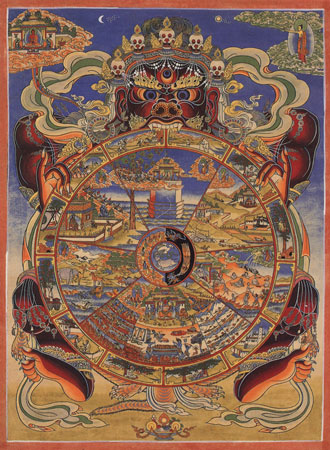Six Paths on:
[Wikipedia]
[Google]
[Amazon]
 The Six Paths in
The Six Paths in
 The Six Paths in
The Six Paths in Buddhist cosmology
Buddhist cosmology describes the planes and realms in which beings can be reborn. The spatial cosmology consists of a vertical cosmology, the various planes of beings, into which beings are reborn due to their merits and development; and a hori ...
. the six worlds where sentient beings are reincarnated according to their karma
Karma (; sa, कर्म}, ; pi, kamma, italic=yes) in Sanskrit means an action, work, or deed, and its effect or consequences. In Indian religions, the term more specifically refers to a principle of cause and effect, often descriptivel ...
s linked to their acts of previous lives. They are represented pictorially in the form of the Bhavacakra
The bhavacakra (Sanskrit: भवचक्र; Pāli: ''bhavacakka''; Tibetan: སྲིད་པའི་འཁོར་ལོ, Wylie: ''srid pa'i 'khor lo'') is a symbolic representation of saṃsāra (or cyclic existence). It is found on the ...
("wheel of existence")."). these are:
# the world of gods or celestial beings (deva
Deva may refer to:
Entertainment
* ''Deva'' (1989 film), a 1989 Kannada film
* ''Deva'' (1995 film), a 1995 Tamil film
* ''Deva'' (2002 film), a 2002 Bengali film
* Deva (2007 Telugu film)
* ''Deva'' (2017 film), a 2017 Marathi film
* Deva ...
) ;
# the world of warlike demigods (asura
Asuras (Sanskrit: असुर) are a class of beings in Indian religions, Indic religions. They are described as power-seeking clans related to the more benevolent Deva (Hinduism), Devas (also known as Suras) in Hinduism. In its Buddhism, Buddhi ...
) ;
# the world of human beings (manushya
Humans in Buddhism (, , Pali ) are the subjects of an extensive commentarial literature that examines the nature and qualities of a human life from the point of view of humans' ability to achieve Bodhi, enlightenment. In Buddhism, humans are jus ...
) ;
# the world of animals ( tiryagyoni) ;
# the world of the starving (preta
Preta ( sa, प्रेत, bo, ཡི་དྭགས་ ''yi dags''), also known as hungry ghost, is the Sanskrit name for a type of supernatural being described in Hinduism, Buddhism, Taoism, and Chinese folk religion as undergoing suffer ...
) ;
# the world of Hell (naraka
Naraka ( sa, नरक) is the realm of hell in Indian religions. According to some schools of Hinduism, Sikhism, Jainism and Buddhism, ''Naraka'' is a place of torment. The word ''Neraka'' (modification of ''Naraka'') in Indonesian and Malaysia ...
).
The first three are called "the three benevolent destinies" (kuśalagati), where beings are more or less virtuous, there is pleasure and there is pain, and the last three are called the three unbenevolent destinies (akuśalagati), where beings lack virtue, there is almost only suffering. We human beings normally only see the animals besides ourselves. The first Buddhist texts mention only five paths, not differentiating between the paths of the devas and the asuras. In Japan, the monk Genshin
, also known as , was the most influential of a number of scholar-monks of the Buddhist Tendai sect active during the tenth and eleventh centuries in Japan. Genshin, who was trained in both esoteric and exoteric teachings, wrote a number of tre ...
even unexplainably places the way of men below that of the asura.
The Pudgala
In Jainism, Pudgala (or ') is one of the six Dravyas, or aspects of reality that fabricate the world we live in. The six ''dravya''s include the jiva and the fivefold divisions of ajiva (non-living) category: ''dharma'' (motion), ''adharma'' (r ...
that transmigrates between these six destinies is not a person or a self, not a soul, but an aggregate (Skandha
(Sanskrit) or (Pāḷi) means "heaps, aggregates, collections, groupings". In Buddhism, it refers to the five aggregates of clinging (), the five material and mental factors that take part in the rise of craving and clinging. They are also ...
), a phenomenal continuity with changing elements.
The elements forming karma
Karma (; sa, कर्म}, ; pi, kamma, italic=yes) in Sanskrit means an action, work, or deed, and its effect or consequences. In Indian religions, the term more specifically refers to a principle of cause and effect, often descriptivel ...
are constituted in bodily, oral or mental volitional acts. The chain of transmigration due to the Three Poisons
The three poisons (Sanskrit: ''triviṣa''; Tibetan: ''dug gsum'') or the three unwholesome roots (Sanskrit: ''akuśala-mūla''; Pāli: ''akusala-mūla''), in Buddhism, refer to the three root kleshas: '' Moha'' (delusion, confusion), ''Raga'' ...
(hatred, greed, ignorance), of which ignorance ('' avidyā'') of the ultimate truth (Sanskrit: ''paramārtha''; Chinese: ''zhēndì'' 真谛) or the true law (Sanskrit: ''saddharma'', सद्धर्म, ''correct law''; Chinese: ''miàofǎ'', 妙法, ''marvelous law'') is generally presented as the source of reincarnation in the three non-benevolent destinies.
See also
*Bhavacakra
The bhavacakra (Sanskrit: भवचक्र; Pāli: ''bhavacakka''; Tibetan: སྲིད་པའི་འཁོར་ལོ, Wylie: ''srid pa'i 'khor lo'') is a symbolic representation of saṃsāra (or cyclic existence). It is found on the ...
References
{{reflist Sanskrit words and phrases Buddhist terminology Pages with unreviewed translations